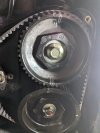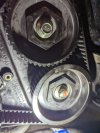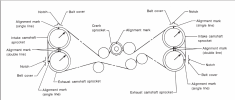- Joined
- Apr 19, 2023
- Messages
- 9
- Reaction score
- 0
Hey all,
I recently got a used Legacy and it's proven to be a lot of work. It blew a cam shaft seal and I've been working on replacing it, while we were at it we decided to replace the timing belt so we bought a timing belt kit online.
We're finally getting it all back together and we just cannot figure out the timing belt. It is very consistently off by one tooth, and always on the driver side bottom cam shaft.
Is this a common issue at all? We've probably taken it off and put it back on like 10 times now. We started it once but it sounded rough, almost like a tractor, but of course we have the radiator and stuff out so I'm not sure if that would have an effect. We let it run for a maximum of 2 seconds.
I'm really at my wits end here and I'm not financially able to bring it in somewhere. Can anyone point me in the right direction? Because I sure need some help.
I recently got a used Legacy and it's proven to be a lot of work. It blew a cam shaft seal and I've been working on replacing it, while we were at it we decided to replace the timing belt so we bought a timing belt kit online.
We're finally getting it all back together and we just cannot figure out the timing belt. It is very consistently off by one tooth, and always on the driver side bottom cam shaft.
Is this a common issue at all? We've probably taken it off and put it back on like 10 times now. We started it once but it sounded rough, almost like a tractor, but of course we have the radiator and stuff out so I'm not sure if that would have an effect. We let it run for a maximum of 2 seconds.
I'm really at my wits end here and I'm not financially able to bring it in somewhere. Can anyone point me in the right direction? Because I sure need some help.





